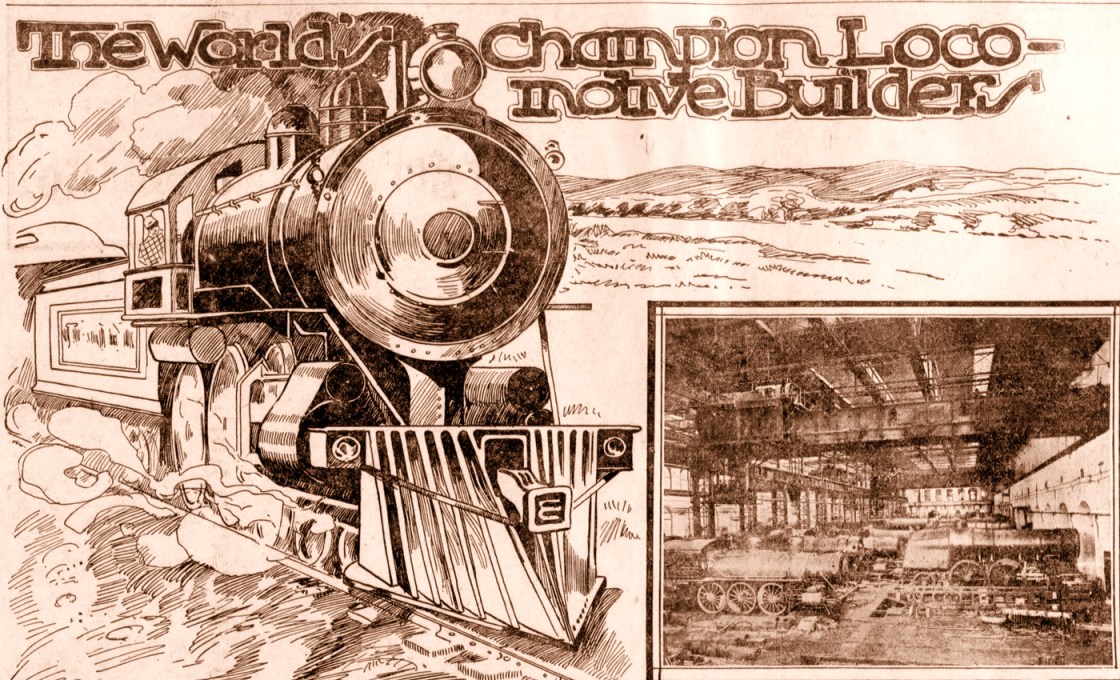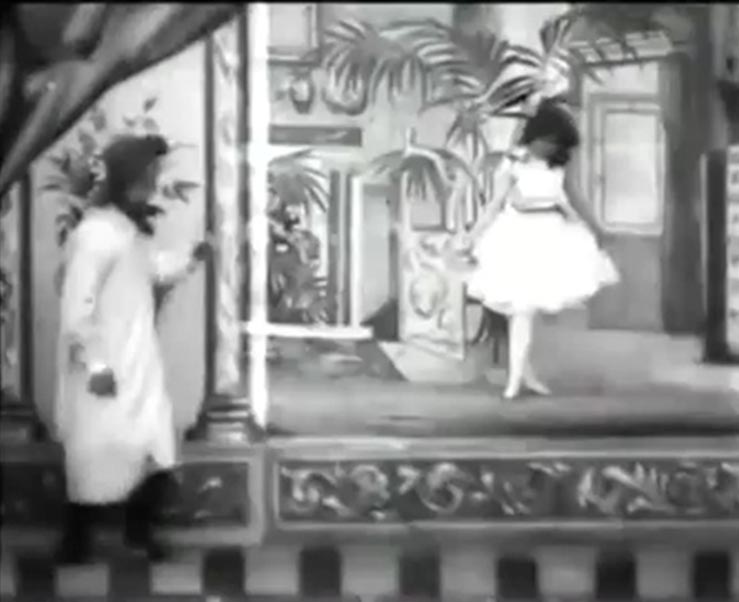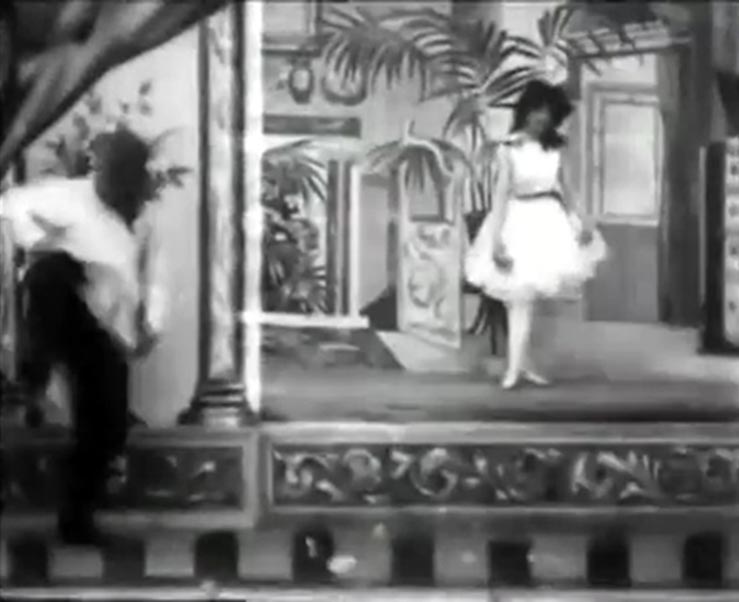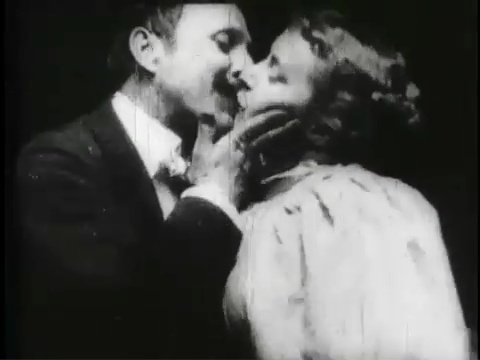A man from the country decides to check out the show at a movie theater and his inability to tell fact from fiction leads to chaos. R.W. Paul poked fun at the motion pictures just six years into the history of projected cinema.
Home Media Availability: Released on DVD.
Seeing is believing.
Early cinema is relatively unexplored outside of academic settings and that’s a shame because it’s rich and adventurous and just a lot of fun. In place of actually viewing films beyond, say, A Trip to the Moon and The Great Train Robbery, we have a selection of pop knowledge factoids. One of the most famous is, of course, the fact that the Lumière film, The Arrival of a Train at La Ciotat Station, caused panic when the audience mistook the footage of a moving train for the real McCoy and fled from its path.
The only problem with this is that, well, it doesn’t actually seem to be true. The lone firsthand account of panic during a screening was shared some twenty years after the event and no other evidence has surfaced. Viewers who shared their experiences when they were fresh agreed that the train scene was thrilling but not actually frightening.
But the idea of an unsophisticated viewer mistaking fiction for reality was too good of a gag to ignore and pioneering English filmmaker R.W. Paul made a comedy short on the subject in 1901, The Countryman and the Cinematograph.
(Nowadays, of course, we are far too sophisticated to mix up cinematic fiction and reality. I mean, it’s not like adults claim that a movie they dislike ruined their collective childhoods or harass actors who play characters they don’t care for. That would be ridiculous.)
The film opens with a gentleman from the country leaping to get a closer look at the picture show on the screen. His smock and hat identify him as a yokel—the smock had been out of favor for decades by 1901 and was seen as pure bumpkin attire. We might compare the costuming in this context to a modern movie portraying the same type of character in a mullet, trucker hat and overalls.
The countryman is amused by the first film, a dancer, and skips along with her performance. But then there is footage of a train chugging along the tracks toward him! The countryman flees in terror but returns to see a country romance playing out on the screen. The film cuts off here.
Unfortunately, we have only a partial print of The Countryman and the Cinematograph but we can get some idea of what the ending was like from the Edison… well, let’s be generous and call it a remake. Uncle Josh at the Moving Picture Show was released in 1902 and follows an identical sequence of events: a dancing girl, panic at a train and then a scene of country romance. Uncle Josh becomes so angry at seeing a country girl romance another man, he tears down the screen and attacks the projectionist. R.W. Paul’s film catalog described a similar final scene in his film.
However, the Edison film is not as polished as Paul’s production. Other than a slight jitter, there is very little to give away the special effects in The Countryman and the Cinematograph. Uncle Josh at the Moving Picture Show, on the other hand, frequently has its leading man’s arm disappearing as he waves it about in front of the double-exposed movie screen. Director Edwin S. Porter would show a firmer grasp of special effects in The Great Train Robbery, released the following year.
Now we have to touch on the giant locomotive in the room: where did fiction end and fact begin with both movies?

Pop film history has swallowed the notion that 1890s audiences were afraid of cinematic trains whole. In fact, you can see the story getting better and better with each telling. “People were surprised by the train!” became “People fell back in their seats in fear!” became “AUDIENCES FLED THE THEATER IN TERROR!” The fact that these anecdotes were not based on contemporary firsthand accounts (or any sources at all) does not matter one bit, the story is here to stay. In fact, The Countryman and the Cinematograph is sometimes used as proof that the panic really occurred.
(The irony of teaching a lesson about people blindly believing what they see on screen… by blindly believing what they see on the screen is not lost on me.)
I will be saving a full debunking for when I cover the Lumière film but here’s the short version:
The idea that audiences panicked at the sight of cinematic trains has been widely considered a myth or at least an extreme exaggeration in scholarly film writing for well over thirty years. The primary matter of debate is how the myth arose, whether there was some grain of truth amidst all the hyperbole and if so, who was doing the panicking.
I am highly indebted to the article Lumière’s Arrival of the Train: Cinema’s Founding Myth by Martin Loiperdinger, which does an excellent job of cutting through the chatter and laying out the facts, or lack thereof, involved in building this myth. He points out that there were no contemporary newspaper or police reports of panicked stampedes from onscreen trains. This is odd as there were reports of police and security guards being hired to manage the crowds trying to get into early screenings. Further, documenting audience reactions to various films was very common in film news coverage of the 1890s.
That being said, somebody was spreading the story, urban legend-style, very early on. Loiperdinger explains that exhibitors were quick to glom onto the panic myth, ostentatiously keeping stretchers on standby and offering first aid to sensitive viewers overwhelmed by this exciting new technology. B-movie king William Castle famously employed similar stunts for his thrillers a half-century later, asking viewers to sign life insurance policies and hiring nurses and hearses to be ready to tend to the victims of death-by-fright. Obviously, we know nobody died at a Castle movie and I think the same level of skepticism is warranted in the case of early films.
Was someone, somewhere startled by a locomotive in a moving picture at some point in time? It’s entirely possible. I was just startled by a stick that resembled a snake in my garden and I am sure I am neither the first nor the last person to have this happen. That doesn’t mean every modern American is afraid of sticks. The real question is whether we should accept the outliers as the standard.
Recently, some online whippersnapper confidently stated that Americans of the late 1990s were thrown into mass panic because they believed all the marketing hoopla surrounding The Blair Witch Project. (You will recall that it was allegedly found footage left by a team of missing and presumed dead filmmakers.) Now, there will always be people who fall for every marketing campaign but I was there and the general consensus was “Huh, interesting. You gonna see it?” But that’s not nearly as fun an anecdote.
What we have in The Countryman and the Cinematograph is a demonstration of the “print the legend” perspective that is ubiquitous in the entertainment industry. The tales of panicked audiences fleeing cinematic trains are almost certainly false or exaggerated beyond recognition but it’s a lot more fun to pretend they were real and have some laughs. I don’t blame R.W. Paul for doing this, he was just out to entertain and it’s not his fault that early film history has been a sometimes-sloppy affair.
Further, there will always be people who do not 100% believe but go along because it’s more amusing that way. I can easily see younger viewers getting a kick out of screaming at the screen as the train approached, not out of actual fear but because that kind of thing would be hilarious to kids. I would have absolutely done it.
One theory that has been put forward is that, as portrayed in The Countryman and the Cinematograph, the urban audiences were too sophisticated to leap back when a train approached the screen, but surely rural viewers would be terrified by those new-fangled galloping tintypes. I can even see this contributing to the origin of the myth. “I’ll bet they’ll panic when they see this in Hickville!”
I am extremely uncomfortable with the theory as it smacks of classism, which we can see reflected onscreen in The Countryman and the Cinematograph. “Look at this rube!” Even in the days before telephones were in every community, let alone every home, word spread quickly. I highly doubt “moving pictures” would have been a great mystery even in the most countrified corners of England for long.
We’ve hit on the key to the myth’s popularity, really. It allows us to look back at our forebears and have a little chuckle at their expense. Afraid of movies? The adorable, naïve Victorians! This ignores the fact that 19th century moviegoers were familiar with movement thanks to animated slideshows and animation contraptions. And if it wasn’t all old timey people, maybe it was just those silly hicks.
(I ran into a similar attitude when researching The Kiss (1896), a film that we have been assured was scandalous and marked the beginning of film censorship. After all, the Gilded Age was full of prudes who couldn’t possibly enjoy a smoochy closeup. In fact, almost nobody was offended and most complaints centered around the kiss not being sexy enough!)
Still, even if it perhaps not an example of art imitating life, The Countryman and the Cinematograph is significant. It’s a very early example of a film within a film and R.W. Paul’s impressive special effects were imitated but not matched by his American counterparts.
With the surviving footage clocking in well under one minute, give this one a shot. It’s certainly worth your time.
Where can I see it?
There’s a video on the region locked BFI player and it’s on region 2 DVD as part of the R.W. Paul collection.
☙❦❧
Like what you’re reading? Please consider sponsoring me on Patreon. All patrons will get early previews of upcoming features, exclusive polls and other goodies.
Disclosure: Some links included in this post may be affiliate links to products sold by Amazon and as an Amazon Associate I earn from qualifying purchases.











You hit the nail on the head when you wrote, “It allows us to look back at our forebears and have a little chuckle at their expense”.
The phrase I dread – and hear far too often (by many people who should know better), when referring to the past is, ‘it was a simpler, more innocent time’.
When it never was.
And it is often the values, attitudes and story telling styles and choices of movies from earlier eras that are pointed to in support of that phrase – which brings us back to your review and your skewering of the supposed panic resulting from the Lumiere train film in the 1890s.
I suppose in a quarter of a century people will look back at our present times, note that mainstream audiences (not only children) were watching magic fantasy superhero movies with a straight face – and be amused at what a simple, innocent age we must have lived in!
Yes, definitely. The magical time of innocence is always right around when nana and papa or mom and dad were kids.
Hello, I just found your blog and it is great. I was looking at your old silent films 101 about the various silent film sources. I found this great Youtube channel that posts silent films and I was wondering if the movies prints they post are any good. https://youtube.com/c/TheSilentFilmChannel. For example I would like to watch their copy of the 1925 reissue of Custer’s Last Fight. Is it similar to the print you saw? Thanks in advance and sorry for the long question.
Thanks for reading! I can’t really endorse any YouTube channel if I don’t know who runs it.